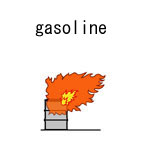| Case Name |
Fire and complete destruction of an oil terminal due to using pipes before finishing repairs |
| Pictograph |

|
| Date |
October 9, 1994 |
| Place |
Ueda, Nagano, Japan |
| Location |
Oil terminal |
| Overview |
The fire was generated at a gasoline tank of an inland oil terminal. First, leakage of oil caused the fire, which spread to three tanks, leading to an explosion. Gasoline gushed out from a joint in piping that workers had forgotten to tighten. The gasoline ignited and a fire broke out. Line-up, which is a basic operation before starting work, was not done. Sparks from a forklift or static electricity generated by the gushing gasoline is supposed to be the fire source. |
| Incident |
A fire occurred during repair work of gasoline piping at an oil terminal. It is not clear what kind of work was performed as the workers were killed. However, it is presumed as following. Transfer of gasoline started before repairs finished. As they began transfer with an un-tightened flange or they opened a block valve before the flange was tightened, gasoline flowed out of the pipe and ignited. |
| Processing |
Storage |
| Substance |
Gasoline |
| Type of Accident |
Leakage, fire |
| Sequence |
First, gasoline caught fire during gasoline leakage from a joint in the piping. Then, the gasoline that leaked inside and outside the oil-retaining wall, and many tanks caught fire. Nearby private houses were damaged by radiant heat from the fire. |
| Cause |
1. A Line-up mistake. The accident was caused almost by human error. (Line up: The preparation work for start-up. Checking whether piping and vessels are connected properly or open/close states of all valves are performed correctly.
2. There is a possibility of communication error between the repair crew and the operation crew, and transfer work started before repairs finished. However, it cannot be overlooked that the operation crew was negligent in line-up work.
The ignition source seems to have been static electricity or a spark from a forklift. |
| Countermeasures |
After the accident, the oil terminal was abolished. It is necessary to strengthen management and prepare a repair manual. As there are a small number of workers on duty on a holiday, better management and more attention are necessary. |
| Knowledge Comment |
There was an error in line-up, which is a basic operation and the first work to be performed. At the main pipe of the piping, such an important operation requires strict double checks or two operators should work together. |
| Background |
1. Disregard of the line-up is considered to be the main cause of the accident. It is supposed that the line-up has been usually neglected or there was some mistakes in the plan of line-up (a part of the manual).
2. The flange left open might have been mistaken for being connected. The repair site required a strict check, but the workers did not care. There might have been a management problem with the work as a whole. |
| Incidental Discussion |
The accident happened in the evening of a holiday. As the workers intended to finish work early, sufficient checks were not made, and the gasoline flowed. It is necessary to pay sufficient attention on restarting an operation. Fires and accidents of these kinds occur too frequently. |
| Reason for Adding to DB |
Example of fire caused due to not rechecking piping after repair |
| Scenario |
| Primary Scenario
|
Misjudgment, Misperception, Mis-Convincement, Ignorance of Procedure, Insufficient Communication, Organizational Problems, Poor Management, Slackness of Management, Usage, Maintenance/Repair, Start Transfer before Finishing of Repair, Malicious Act, Rule Violation, Safety Rule Violation, Secondary Damage, External Damage, Fire, Bodily Harm, Injury, Loss to Organization, Economic Loss, Direct Monetary Damage 110 million yen, Loss to Organization, Social Loss, Closing Oil Terminal
|
|
| Sources |
Fire and Disaster Management Agency. Major cases of accidents Fire caused by leakage of gasoline at an oil terminal under construction. Accident cases of dangerous materials. pp.30, 132-134.
High Pressure Gas Safety Inst. of Japan, High-pressure gas protection overview. pp.276-277 (1995).
Ueda region local government office union Fire-Defense Headquarters. Shouichi Miyashita Lessons, future guidance, and countermeasures from a large scale fire at an oil terminal. Dangerous material accident case seminar. pp.11-12 (1995).
|
| Number of Deaths |
3 |
| Number of Injuries |
1 |
| Physical Damage |
Rain gutters and walls of housing located within 43 m of the burn-out tank were deformed and discolored. Tanks and the tank lorry station were destroyed by fire. 244.7 kL of gasoline and 7.7 kL of gas oil burned. |
| Financial Cost |
¥ 113 million. (Accident cases of dangerous materials) |
| Consequences |
The JR line stopped temporarily |
| Notes |
1. The company must try to prevent recurrence by enhancing consciousness of disaster prevention. (The company has similar facilities, even if these facilities were abolished.)
2. An inner floating roof-type tank was installed to prevent evaporation of combustible vapor as an environmental countermeasure. At the time of this accident, it was also proved to be useful for preventing the spread of fire.
3. As housing was located close to this terminal, there was damage to the houses by radiant heat. |
| Field |
Chemicals and Plants
|
| Author |
KOSEKI, Hirosi (National Research Institute of Fire and Disaster)
TAMURA, Masamitsu (Center for Risk Management and Safety Sciences, Yokohama National University)
|